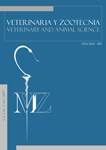Authors
Abstract
ABSTRACT: Two suture monofilament nonabsorbable elements were evaluated, Polypropylene and Polyamide (fishing nylon) implanted in the skin of twenty canines, divided in two groups. This estimation was put in practice by means of the qualification of the local inflammatory reaction and with the presence or absence of dehiscence in the suture; ten days after the stitches were taken away. Using the polypropylene as suture material, a significant statistic difference (P<0,05) between the inflammation levels was seen in the following manner: absent 8%, minimum 69% of the cases, and moderate 23%. As for the use of Polyamide, a significant statistic difference (P<0,05) was seen in regards to the minimum inflammation level with a 66.5% of the cases, with regards to the other levels. The comparison between the kinds of suture (polypropylene y polyamide) didn’t show a significant statistic difference (P≥0,05) based on the different grades of inflammatory reaction provoked by them, and in none of the cases where they were used, they didn´t cause a severe inflammatory reaction, nor were there significant statistic differences in the evaluation of the incident of postsurgical dehiscence during the following ten days. This work also infers that under the conditions and the parameters evaluated, no significant differences were found between the materials used to fasten the coetaneous tissue in canines.
Keywords
References
Beroza, G.; Perry, R.; Cotter D. Celiotomy closure via permanent implantation of polyamide in horses. Equine Veterinary Journal, v.32, p.101-103, 2000.
Chu, C. Mechanical Properties of Suture Materials. Annals of Surgery, v.193, n.3, p.365-371,1983.
Fossum, T. Biomateriales, sutura y hemostasia. En: Fossum, T.; Hedlund, C.; Hulse, D. et al. Cirugía en pequeños animals. 2. ed. Buenos Aires: Intermédica, 2004. p.45-62.
Gahleitner, M.; Kretzschmar, B.; Pospiech, D. et al. Morphology and mechanical properties of polypropylene/polyamide 6 nanocomposites prepared by a two-step melt-compounding process. Journal of Applied Polymer Science, v.100, n.1, p.283-291, 2006.
Holmlund, D. Physical properties of surgical suture materials: Stress-strain relationship, stress-relaxation and irreversible elongation. Annals of Surgery, v.184, n.2, p.189-193, 1976.
Israelsson, L.; Jonsson, T. Suture length to wound lenght ratio and healing of midline laparotomy incisions. The British Journal of Surgery, v.80, n.10, p.1284-1286, 1993.
Madsen, E. An experimental and clinical evaluation of surgical suture material. Surgery, Ginecology & Obstetric, v.97, n.1, p.73-80, 1953.
Maldonado, F.; Muñoz, L.; Quesada, M. et al. Reacción tisular a materiales de sutura no absorbibles en piel de equinos. Archivos de Medicina Veterinaria, v.38, n.1, p.63-67, 2006.
Osterberg, B. Enclosure of bacteria within capillary multifilament sutures as protection against leukocytes. Acta Chirurgica Scandinavica, v.149, n.7, p.663- 668, 1983.
Osterberg, B.; Blomstedt, B. Effect of suture materials on bacterial survival in infected wounds. An experimental study. Acta Chirurgica Scandinavica, v.145, n.7, p.431-434, 1979.
Rath, A.; Attali, P.; Dumas, J. et al. The abdominal linea alba: an anatomo-radiologic and biomechanical study. Surgical and Radiologic Anatomy, v.18, n.4, p.281- 288, 1996.
Roush, J. Biomateriales e implantes Quirúrgicos. En: Slatter, D. Tratado de cirugía de pequeños animales. 3. ed. Buenos Aires, República Argentina: Inter-Médica, p.45, 2006.
Smeak, D. Selección y empleo de los materiales y agujas de sutura disponibles en la actualidad. En: Bojrab, J. Técnicas actuales en cirugía de pequeños animales. 4. ed. Buenos Aires: Intermédica, p. 17-23, 2001.
Wood, D.; Collins, J.; Walshaw, R. Tissue reaction to nonabsorbable suture materials in the canine linea alba: a histological evaluation. Journal of the American Animal Hospital Association, v.20, n.1, p.39-44, 1984.

 PDF (Español)
PDF (Español)
 FLIP
FLIP










